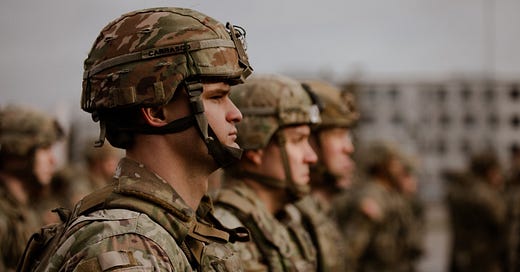Military Recruiting Crisis
Two decades of war, a labor shortage, and a lack of national purpose have left the military 25% short of its recruiting targets
In 1973, the US ditched the draft and moved to an all-volunteer military. There were no major wars until 9/11 and since then the US has nearly been constantly at war in the Global War on Terror. In 2022, the US military faced recruiting shortfalls in all branches of service. The Wall Street Journal has done a piece on this very important issue, which is excerpted here:
The children of military families make up the majority of new recruits in the U.S. military. That pipeline is now under threat, which is bad news for the Pentagon’s already acute recruitment problems, as well as America’s military readiness.
After the patriotic boost to recruiting that followed 9/11, the U.S. military has endured 20 years of war in Iraq and Afghanistan with no decisive victories, scandals over shoddy military housing and healthcare, poor pay for lower ranks that forces many military families to turn to food stamps, and rising rates of post-traumatic stress disorder and suicide.
At the same time, the labor market is the tightest it has been in decades, meaning plenty of other options exist for young people right out of school.
U.S. recruiting shortfalls represent a long-term problem that, if not resolved, would compel the military to reduce its force size. With America embarking on a new era of great-power competition with China and Russia, that problem has become more serious.
The U.S. Army in 2022 had its toughest recruiting year since the advent of the all-volunteer military in 1973 and missed its goal by 25%. This year, it expects to end up about 15,000 short of its target of 65,000 recruits.
The Navy expects to fall short by as many as 10,000 of its goal of nearly 38,000 recruits this year, and the Air Force has said it is anticipating coming in at 3,000 below its goal of nearly 27,000. The Marine Corps met its target last year of sending 33,000 to boot camp, and expects to meet its goals this year, but its leaders described recruitment as challenging.
Only 9% of young people ages 16-21 said last year they would consider military service, down from 13% before the pandemic, according to Pentagon data.
Today, nearly 80% of all new Army recruits have a family member who has served in uniform, according to the service. That can be a good thing, said Col. Mark Crow, director of the Office of Economic and Manpower Analysis at West Point, because “people who know the most about it stick around.”
Depending too much on military families could create a “warrior caste,” Wormuth said. Her plans seek to draw in people who have no real connection to the military and to broaden the appeal of service.
The sudden and unpopular conclusion to the war in Afghanistan in 2021 added to the disenchantment of some veterans, including Catalina Gasper, who served in the Navy. Gasper said she and her husband, who spent more than two decades in the Army, used to talk to their boys, now 7 and 10, about their future service, asking them if they wanted to be Navy SEALs.
In July 2019, on her last combat deployment to Afghanistan, she was stationed at a base in Kabul when the Taliban launched an attack. The blast battered Gasper’s body and she was transported back to the U.S. for treatment and recovery.
She was left with lingering damage from a traumatic brain injury. She is sensitive to loud sounds and bright lights. She has recurrent dizziness and forgets words. She also has bad knees and herniated discs in her back.
The U.S. pulled out of Afghanistan in the summer of 2021, precipitating Kabul’s fall to the Taliban. “We’re left with the gut-wrenching feeling of, ‘What was it all for?’ ” she said.
She said she was a patriot but decided she would do everything she could to make sure her kids never enter the military. “I just don’t see how it’s sustainable if the machine keeps chewing up and spitting out” our young people, she said
The Department of Defense said 77% of American youth are disqualified from military service due to a lack of physical fitness, low test scores, criminal records including drug use or other problems. In 2013, about 71% of youth were ineligible.
Department of Defense officials have said they will have to address the total combat power of the military if the recruiting crisis continues, but that they aren’t ready to yet talk about whether strength will ultimately be affected.
Readiness shortfalls can be masked when units aren’t headed into war, but a full-scale response, such as what would be needed in the Pacific, could expose undermanned units that can’t be deployed or aren’t effective, and ships and aircraft that aren’t combat ready due to a lack of personnel to maintain them.[i]
The solution to this problem is multifaceted but one element is instituting a volunteer National Service Program, similar to what Israel has today. 18-year-olds could sign contracts with the government (12+ months) to serve in the military, as nurses, coders, or in other high demand jobs. They would get a stipend, training, experience, and exposure to a diverse slice of America. Future employers would seek graduates, just like they seek veterans today. The government should also pay for future schooling of graduates, like the GI bill. This is a policy that Ad Astra will explore in future articles.
[i] https://www.wsj.com/articles/military-recruiting-crisis-veterans-dont-want-their-children-to-join-510e1a25?reflink=integratedwebview_share





